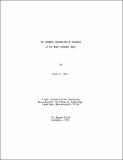| dc.contributor.author | Dear, Roger George | en_US |
| dc.contributor.other | Massachusetts Institute of Technology. Flight Transportation Laboratory | en_US |
| dc.date.accessioned | 2012-01-06T06:56:54Z | |
| dc.date.available | 2012-01-06T06:56:54Z | |
| dc.date.issued | 1976 | en_US |
| dc.identifier | 03159167 | en_US |
| dc.identifier.uri | http://hdl.handle.net/1721.1/67982 | |
| dc.description | Originally presented as the author's thesis, (Ph. D.) in the M.I.T. Dept. of Electrical Engineering and Computer Science, 1976 | en_US |
| dc.description | September 1976 | en_US |
| dc.description | Includes bibliographical references (p. 316-318) | en_US |
| dc.description.abstract | Aircraft arrive in a random fashion into a terminal area seeking to land at a given runway. The aircraft are differentiated by their landing velocities. All aircraft are required to maintain a prespecified minimum horizontal separation distance and also fly on a common final approach. As a consequence, the minimum interarrival time separation is interactive, i.e., a function of the landing velocities of the preceding and following aircraft as well as the separation minimum and final approach length. The controller's decision-making problem in sequencing the aircraft, termed dynamic scheduling, is formulated in this dynamic environment. It is observed that the first-come, first-serve discipline is inefficient and the system properties employing optimality objectives of maximum throughput and minimum delay are investigated. The solutions must be updated with each new arrival and, as a result, the solutions employing these optimality objectives are shown to have undesirable properties, including 1) a priority structure with the potential for indefinite delay; 2) non-implementable updating assignments; 3) computationally intractable solutions in real time. As a consequence of this analysis, a decision methodology termed Constrained Position Shifting (CPS) is proposed to eliminate these undesirable properties. CPS prohibits an aircraft from being shifted more than a given number of positions from its first-come, first-serve position. The CPS methodology is then shown via simulation to be practical, efficient and extremely flexible, with the following properties: 1. increases the runway throughput rate; 2. treats individual aircraft equitably; 3. treats aircraft velocity classes equitably; 4. particularly successful during peak periods; 5. well within the capabilities of today's computers. The simulation is designed to compare identical arrival streams under various strategies. The simulation-aided analysis is then extended to include "heavy" jets (with aircraft dependent separation minima) and also mixed operations (arrivals and departures). Even greater improvements in terminal area levels of service are demonstrated for these extensions. | en_US |
| dc.format.extent | 325 p | en_US |
| dc.publisher | Cambridge, Mass. : Flight Transportation Laboratory, Massachusetts Institute of Technology, [1976] | en_US |
| dc.relation.ispartofseries | FTL report (Massachusetts Institute of Technology. Flight Transportation Laboratory) ; R76-9 | en_US |
| dc.subject | Airports | en_US |
| dc.subject | Air traffic control | en_US |
| dc.subject | Production scheduling | en_US |
| dc.subject | Traffic control | en_US |
| dc.subject | Mathematical models | en_US |
| dc.title | The dynamic scheduling of aircraft in the near terminal area | en_US |
| dc.type | Technical Report | en_US |

